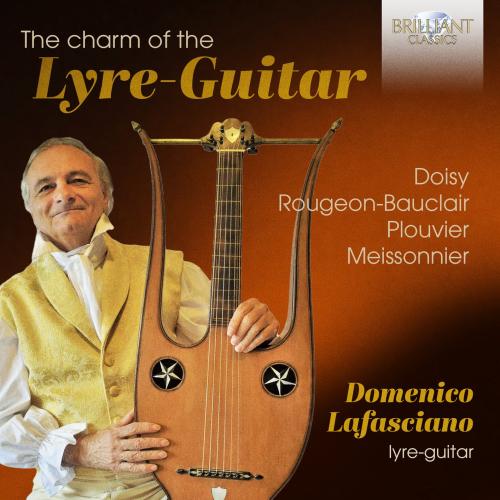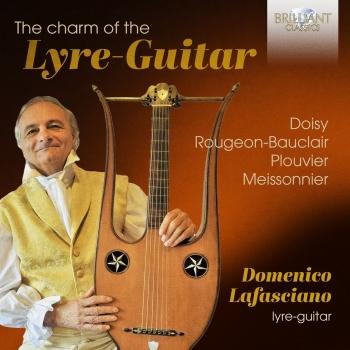
The Charm of the Lyre-Guitar Domenico Lafasciano
Album info
Album-Release:
2024
HRA-Release:
26.07.2024
Label: Brilliant Classics
Genre: Classical
Subgenre: Instrumental
Artist: Domenico Lafasciano
Composer: Jean-Antoine Meissonnier (1783-1857), Pierre Joseph Plouvier (1750-1825), Charles Doisy (1750-1804), Alexandre Alfred Rougeon-Beauclair (1762-1829)
Album including Album cover Booklet (PDF)
- Charles Doisy (1748 - 1807): 12 Petits airs faciles:
- 1 Doisy: 12 Petits airs faciles: I. Moderato 01:10
- 2 Doisy: 12 Petits airs faciles: II. Walse 00:54
- 3 Doisy: 12 Petits airs faciles: III. Walse 01:19
- 4 Doisy: 12 Petits airs faciles: IV. Sérénade (Maestoso - Presto) 03:36
- 5 Doisy: 12 Petits airs faciles: V. Andante 01:34
- 6 Doisy: 12 Petits airs faciles: VI. Kosak 02:15
- 7 Doisy: 12 Petits airs faciles: VII. Polonoise 02:17
- 8 Doisy: 12 Petits airs faciles: VIII. Andantino - Variation 03:15
- 9 Doisy: 12 Petits airs faciles: IX. Andantino (Sicilienne) - Variation) 04:07
- 10 Doisy: 12 Petits airs faciles: X. Rondo (Allegretto) 02:09
- 11 Doisy: 12 Petits airs faciles: XI. Walse 01:14
- 12 Doisy: 12 Petits airs faciles: XII. Walse 01:27
- Alexandre Alfred Rougeon-Bauclair: 12 Walses et un thème varié, Op. 8:
- 13 Rougeon-Bauclair: 12 Walses et un thème varié, Op. 8: I. Walze 1 01:17
- 14 Rougeon-Bauclair: 12 Walses et un thème varié, Op. 8: II. Walze 2 01:16
- 15 Rougeon-Bauclair: 12 Walses et un thème varié, Op. 8: III. Walze 3 01:34
- 16 Rougeon-Bauclair: 12 Walses et un thème varié, Op. 8: IV. Walze 4 01:14
- 17 Rougeon-Bauclair: 12 Walses et un thème varié, Op. 8: V. Walze 5 01:17
- 18 Rougeon-Bauclair: 12 Walses et un thème varié, Op. 8: VI. Walze 6 01:14
- 19 Rougeon-Bauclair: 12 Walses et un thème varié, Op. 8: VII. Walze 7 01:31
- 20 Rougeon-Bauclair: 12 Walses et un thème varié, Op. 8: VIII. Walze 8 01:16
- 21 Rougeon-Bauclair: 12 Walses et un thème varié, Op. 8: IX. Walze 9 01:24
- 22 Rougeon-Bauclair: 12 Walses et un thème varié, Op. 8: X. Walze 10 01:04
- 23 Rougeon-Bauclair: 12 Walses et un thème varié, Op. 8: XI. Walze 11 01:15
- 24 Rougeon-Bauclair: 12 Walses et un thème varié, Op. 8: XII. Walze 12 01:03
- Thème varié:
- 25 Rougeon-Bauclair: Thème varié 06:53
- Pierre Joseph Plouvier (1750 - 1826): Allemandes, rondeaux, sauteuses & anglaises:
- 26 Plouvier: Allemandes, rondeaux, sauteuses & anglaises: I. Moderato 01:20
- 27 Plouvier: Allemandes, rondeaux, sauteuses & anglaises: II. Allegretto 01:05
- 28 Plouvier: Allemandes, rondeaux, sauteuses & anglaises: III. Moderato 01:11
- 29 Plouvier: Allemandes, rondeaux, sauteuses & anglaises: IV. Allegretto 00:58
- 30 Plouvier: Allemandes, rondeaux, sauteuses & anglaises: V. Poco andante 00:52
- 31 Plouvier: Allemandes, rondeaux, sauteuses & anglaises: VI. Allegretto 01:31
- 32 Plouvier: Allemandes, rondeaux, sauteuses & anglaises: VII. Poco allegro 01:00
- 33 Plouvier: Allemandes, rondeaux, sauteuses & anglaises: VIII. Andante 02:09
- 34 Plouvier: Allemandes, rondeaux, sauteuses & anglaises: IX. Allegretto 01:17
- 35 Plouvier: Allemandes, rondeaux, sauteuses & anglaises: X. Allegretto 00:54
- 36 Plouvier: Allemandes, rondeaux, sauteuses & anglaises: XI. Tempo giusto 02:07
- 37 Plouvier: Allemandes, rondeaux, sauteuses & anglaises: XII. Poco andante 01:08
- Jean Antoin Meissonier (1783 - 1857): 4 Nocturnes:
- 38 Meissonier: 4 Nocturnes: I. 1er Rondo (Gratiozo) 02:00
- 39 Meissonier: 4 Nocturnes: II. 2ème Rondo (Escherzando) 02:53
- 40 Meissonier: 4 Nocturnes: III. 3ème Rondo (Allegretto con gusto) 02:55
- 41 Meissonier: 4 Nocturnes: IV. 4ème Rondo (Andante expressivo - Andantino) 02:40
Info for The Charm of the Lyre-Guitar
The lyre-guitar was a fascinating, upmarket instrument that originated in Paris. Its inventor, luthier Pierre-Charles Mareschal, dated its creation to around 1780. It was very popular in the elite salons of Napoleonic era-Europe, between the late 18th and early 19th century. Its refined, elegant shape recalling the ancient Greek lyre, made it a much-vaunted status symbol among women, who believed it enhanced their grace and beauty. As well as being played by noblewomen, it was also used by musicians to accompany singers, including the French tenor Joseph Dominique Fabry-Garat and the Austrian baritone Johann Michael Vogl, a close friend of Franz Schubert.
The lyre-guitar used on this recording comes from Domenico Lafasciano’s private collection. It was built in Paris in 1806 by Henry Lejeune, part of an important dynasty of luthiers dating back to the 18th century. Lafasciano’s lyre-guitar is an original and very rare instrument: it has only 12 frets, and they are made of gut like on the lute or baroque guitar, making it suitable for playing works from the early 19th-century guitar repertoire. It is a brilliant example of the transition between the 18th and 19th centuries, a period when guitarists were still playing instruments with five double or single courses of strings, as well as six-string models. It appears that the lyre-guitar, which had six single strings from the outset, gave a definitive push to the addition of the sixth string to the guitar.
This album contains some lovely musical gems written in the early 19th century by guitar-playing composers who remain largely unknown today. The first French publications, including the pieces featured on this recording, all contained the words ‘pour Lyre ou Guitare’ or ‘pour Guitare ou Lyre’, indicating very clearly that the works could be performed on either a lyre-guitar (‘Lyre’) or a five- or six-string guitar (‘Guitare’).
Domenico Lafasciano, lyre-guitar
Domenico Lafasciano
Graduated with top marks at Padua Conservatory, from the 70's he perfected himself with Alirio Diaz, Alexandre Lagoya, Siegfried Behrend and José Luis Lopategui.
Amongst his numerous private meetings, stand out the ones with Andrés Segovia, who let him play his own guitar, with John W.Duarte, who dedicated him his composition “Danza eccentrica”, and with Leo Brouwer, who wrote “He escuchado la obra de Domenico Lafasciano en Milàn y celebro su dominio”.
From 1978 to this day he played in the biggest cities and capitals of 36 States, from Europe to America, Africa, Asia and Australia, as an embassy's guest to represent Italy around the World.
Some of his concerts' sites: Melba Hall Conservatorium-Melbourne, New York University, Gedung Kesenian-Jakarta, Cité internationale universitaire de Paris,Liederhalle-Stuttgart, Palacio de Abrantes-Madrid, Burgerratssaal Casino-Bern, State Philharmonic of Minsk, Teatro Manzoni e Sala Verdi del Conservatorio di Milano, Accademia Nazionale di San Luca-Roma, Florianka Concert Hall-Krakow, Palais Moulay Hafid-Tangier, Malta’s National Theatre, Palácio Nacional de Queluz-Lisboa, Marseille (European Paganini Route), Festival Ballades a Bourges, Dublin Guitar Week, Pechino (Settimana della Cultura italiana in Cina), XXI Festival Cultural de Zacatecas-Messico, Jazz International Festival di Città del Guatemala and also Monaco di Baviera, Bruxelles, Lussemburgo, Amsterdam, Londra, Copenaghen, Oslo, Stoccolma, Helsinki, Bucarest, Budapest, Varsavia, Salonicco, Casablanca, Siviglia,vj Tripoli, Montreal, Kiev.
In 1994 he shared the stage in Belgium with flamenco guitarist Vicente Amigo, each of them representing their own Nation.
Several of his interpretations and interviews have been broadcasted by: Rai Radiotelevisione italiana, Radio Vaticana, Bayerischer Rundfunk (Germany), Televisione Svizzera, Österreich Rundfunk (Austria), Radio Romania Music Channel, Belaruskae Radio e Nazionalnoe Televidenie (Belarus), 2M Telèvision (Morocco), Libya Tv, Dalian Television (China), Radio Republik Indonesia, Rete Italia (Australia), all of the biggest television and radio channels of Guatemala and Mexico States, and many others.
In 1998 he was the first one to hold a guitar Recital at the National Theatre of Bengasi (Libia).
In September 2001, invited by the New York University, he held a Recital in Manhattan, dedicated to the victims of the World Trade Center. In a letter of gratitude from the University was written: “...Dear Maestro Lafasciano, your Concert here was one of the most effective ways to help New York in this terrible moment of its history...”.
In 2007, at the Plaza de las Artes, in front of an audience of about 4.000 people, applauded with standing ovation, he represented Italy at Festival Euro Jazz of Mexico City (Event patronised by the European Union).
In 2018, for his 40 years of carreer anniversary the book “Domenico Lafasciano – Classico oltre i Confini” was published by Edizioni Musicali Sinfonica.
In 2020 he was honoured to to play the French guitar Ory-Koliker from 1797, owned by Niccolò Paganini, during the 19th Paganinian Festival in Carro.
He held about fourty Master Classes in several Countries around the World, for instance: Conservatorio Profesional de Musica de Zaragoza (Spagna), Liceul de Muzica “G.Enescu”- Bucarest (Romania), Akademia muzyczna-Kraków (Poland), State Academy of Music-Minsk (Belarus), Dalian Art College (China), Johann Strauss School of Music-Valletta (Malta), State University of Jakarta (Indonesia), Escuela Superior de Musica (Ciudad de México), Conservatoire de Musique-Casablanca (Morocco), Dim Master Klass (Kiev-Ucraina).
In Italy he was professor and held Master Classes and guitar Workshops at the Music Conservatories of Milan, Udine, Sassari, Teramo, L'Aquila and Campobasso.
He issued about fifty publications, from books to scores and cd's with Italy, Switzerland, Germany and Japan editors.
He was Member and President of more than 30 international guitar contests, such as the ones in Milan (for 11 years in a row), Rome “Alirio Diaz” and Athene “Dimitri Fampas”.
He is Founder and Artistic Director of the Chamber Music Contest “Milano City” and Guitar Festival “Augusta Taurinorum”.
Amongst the several artists he played concerts with we note the guitarist Siegfried Behrend, the violinist Marco Fornaciari, the Quartet of Solistes de l'Ensemble Orchestral de Genéve, the Arion Quartet, the Indaco Quartet, the Deutsche Zupforchester with the mandolinist Takashi Ochi, the flautists Marlaena Kessick, Florin Ouatu, Luc Urbain, the jazzists Enrico Intra and Franco Cerri, the drummer and pop singer Tullio De Piscopo, the actor Alessandro Quasimodo.
He was testimonial of Spanish guitars Ramirez e Camps and he is endorser of Aquila strings.
Domenico Lafasciano is one of the very few concert performers of Lyre-Guitar of all times.
Besides his music activity he also works as an actor for films directed by Pupi Avati, Angelo Antonucci. Manetti Bros and various Rai-TV fictions.
Booklet for The Charm of the Lyre-Guitar















